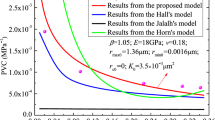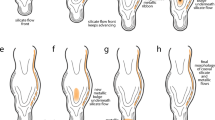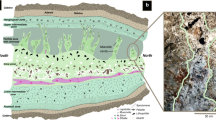Abstract
IGNEOUS rocks formed from lava flows of the Archaean era (>2,700 million years ago) are often found to contain disequilibrium-textured crystals characterized by spherulitic, branching or dendritic morphologies that occur in layers near the flow surface. Well-known examples are the plagioclase spherulites of basalts and the platy and branching spinnifex-textured olivines and pyroxenes of komatiites1,2. Here we present evidence that, over a finite range of length scales, some disequilibrium textures are scale invariant. This observation implies that over this range of length scales their random patterns can be quantitatively characterized by a unique number, the fractal dimension3. We also demonstrate that some textures have a crossover from fractal to non-fractal behaviour. It is known that most disequilibrium crystals arise in part from rapid cooling and represent the case where the growth rates of the crystals are large compare to the diffusion rates in the silicate melt1,2,4. We therefore formulate a quantitative model for the growth that is based on a variant of diffusion-limited aggregation (DLA) 5.
This is a preview of subscription content, access via your institution
Access options
Subscribe to this journal
Receive 51 print issues and online access
$199.00 per year
only $3.90 per issue
Buy this article
- Purchase on Springer Link
- Instant access to full article PDF
Prices may be subject to local taxes which are calculated during checkout
Similar content being viewed by others
References
Lofgren, G. Am. J. Sci. 274, 243–273 (1974).
Donaldson, C. H. Contr. Miner. Petrol. 57, 187–213 (1976).
Mandelbrot, B. B. The Fractal Geometry of Nature (Freeman, New York, 1983).
Keith, H. D. & Padden, F. J. Jr J. appl. Phys. 34, 2409–2421 (1963).
Witten, T. A. & Sander, L. M. Phys. Rev. Lett. 47, 1400–1403 (1981).
Fowler, A. D., Jensen, L. S. & Peloquin, A. S. Can. Mineralogist 25, 275–289 (1987).
Stanley, H. W. Fractals and Multifractals: An Introduction (Oxford University Press, in the press).
Witten, T. A. & Meakin, P. Phys. Rev. B28, 5632–5642 (1983).
Nittmann, J. & Stanley, H. E. Nature 321, 663–668 (1986).
Yang, C.-L., Chen, Z.-Y. & El-Sayed, M. A. J. phys. Chem. 91, 3002–3006 (1987).
Collins, F. C. & Kimball, G. E. J. Colloid Sci. 4, 125–137 (1949).
Rice, S. A. Diffusion-Limited Reactions (Elsevier, New York, 1985).
Daccord, G. Phys. Rev. A39, 1365–1368 (1989).
Donaldson, C. H. Lithos 8, 163–174 (1975).
Clark, A. H., Pearce, T. H., Roeer, P. L. & Wolfson, I. Am. Miner. 71, 734–741 (1986).
Author information
Authors and Affiliations
Rights and permissions
About this article
Cite this article
Fowler, A., Stanley, H. & Daccord, G. Disequilibrium silicate mineral textures: fractal and non-fractal features. Nature 341, 134–138 (1989). https://doi.org/10.1038/341134a0
Received:
Accepted:
Issue Date:
DOI: https://doi.org/10.1038/341134a0
This article is cited by
-
Quenching of basaltic melts by volatile exsolution
Contributions to Mineralogy and Petrology (2023)
-
Internal stratigraphic architecture of the komatiitic dunite-hosted MKD5 disseminated nickel sulfide deposit, Mount Keith Domain, Agnew-Wiluna Greenstone Belt, Western Australia
Mineralium Deposita (2007)
-
A developmental model of olivine morphology as a function of the cooling rate and the degree of undercooling
Contributions to Mineralogy and Petrology (2003)
-
Harrisitic textures in the Centre Hill complex, Munro Township, Ontario: product of diffusion limited growth
Mineralogy and Petrology (1995)
Comments
By submitting a comment you agree to abide by our Terms and Community Guidelines. If you find something abusive or that does not comply with our terms or guidelines please flag it as inappropriate.



